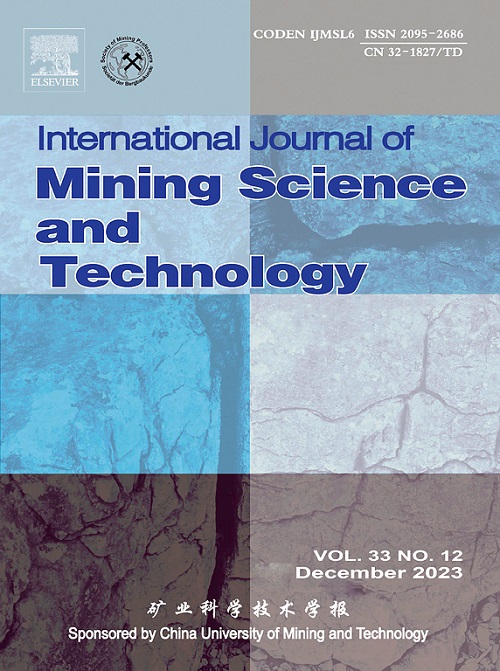聚能爆破能量调节机理及介质填充效果
IF 13.7
1区 工程技术
Q1 MINING & MINERAL PROCESSING
International Journal of Mining Science and Technology
Pub Date : 2025-05-01
DOI:10.1016/j.ijmst.2025.03.010
引用次数: 0
摘要
能量聚焦爆破是实现定向压裂的一种创新而巧妙的方法。了解其能量调节机制对提高其实际有效性至关重要。通过理论分析、数值模拟和模型试验,研究了能量调节机理,探讨了聚能爆破中的介质填充效应。理论和数值分析结果首先表明,裂缝定向扩展受压裂和拉伸两个阶段的控制,其中非能量聚焦方向的爆炸能量被抑制,压缩井壁,而重定向能量在能量聚焦方向产生拉应力,驱动定向裂缝的形成。填充介质的选择对定向裂缝的能量分布和调节有重要影响,而填充介质的波阻抗和可压缩性等关键性能至关重要。以空气、砂和水为填充介质的实验对比进一步揭示了介质对能量调节和定向裂缝扩展的显著影响。在能量聚焦方向上,空气、砂土和水的形能系数最大值分别为1.30、4.41和6.12。同时,空气、砂土、水的应力衰减速率依次增大。较高的波阻抗和较低的水压缩率支持能量高效、均匀的传播,潜在性地增强了聚焦方向的拉伸作用,加剧了聚焦爆破的整体应力冲击。非能量聚焦方向的应力随与能量聚焦方向夹角的增大而减小,空气和水的应力相对均匀,砂土的应力明显不均匀;同时,在空气、水和砂的情况下,爆破裂缝的分形维数分别为1.076、1.068和1.112。砂土作为充填介质,由于其颗粒性和非均质性,导致裂缝不规则性增加。水介质通过促进爆破能量转移和优化能量分布达到最佳平衡,使聚能爆破过程中定向裂缝的平整度保持在最小。本文章由计算机程序翻译,如有差异,请以英文原文为准。
Energy regulation mechanism and medium-filling effect of energy-focusing blast
The energy-focusing blast is an innovative and ingenious method to achieve directional fracturing. Understanding its energy regulation mechanism is critical to enhancing its practical effectiveness. This study investigates the energy regulation mechanism and explores the medium-filling effects within the energy-focusing blast by employing theoretical analysis, numerical simulations, and model tests. The findings by theoretical and numerical analysis first reveal that two stages of the fracturing and tensile stage govern the directionally crack propagation, in which the explosion energy in the non-energy-focusing direction is suppressed, compressing the borehole wall, while redirected energy produces tensile stress in the energy-focusing direction, driving the formation of directional cracks. The choice of filling medium significantly affects directional cracking due to its impact on energy distribution and regulation, and key properties such as wave impedance and compressibility of the filling medium are critical. Experimental comparisons using air, sand, and water as filling media further disclose the distinct effects of the medium on energy regulation and directional crack growth of the energy-focusing blast. The maximum shaped-energy coefficients for air, sand, and water are 1.30, 4.41, and 6.12 in the energy-focusing direction, respectively. Meanwhile, the stress attenuation rate of air, sand, and water increases in that order. The higher wave impedance and lower compressibility of water support efficient and uniform energy propagation, which subtly enhances the tensile actions in the focusing direction and intensifies the overall stress impact of the energy-focusing blast. In addition, the stresses in the non-energy-focusing directions decrease as the angle from the energy-focusing direction increases, while the stresses are relatively uniform for both air and water but noticeably uneven for sand; meanwhile, the fractal dimensions of blasting cracks in the case of air, water, and sand are 1.076, 1.068, and 1.112, respectively. Sand as a filling medium leads to increased crack irregularities due to its granularity and heterogeneity. The water medium strikes an optimal balance by promoting the blasting energy transition and optimizing the energy distribution, maintaining the least flatness of the directional crack during energy-focusing blasts.
求助全文
通过发布文献求助,成功后即可免费获取论文全文。
去求助
来源期刊

International Journal of Mining Science and Technology
Earth and Planetary Sciences-Geotechnical Engineering and Engineering Geology
CiteScore
19.10
自引率
11.90%
发文量
2541
审稿时长
44 days
期刊介绍:
The International Journal of Mining Science and Technology, founded in 1990 as the Journal of China University of Mining and Technology, is a monthly English-language journal. It publishes original research papers and high-quality reviews that explore the latest advancements in theories, methodologies, and applications within the realm of mining sciences and technologies. The journal serves as an international exchange forum for readers and authors worldwide involved in mining sciences and technologies. All papers undergo a peer-review process and meticulous editing by specialists and authorities, with the entire submission-to-publication process conducted electronically.
 求助内容:
求助内容: 应助结果提醒方式:
应助结果提醒方式:


